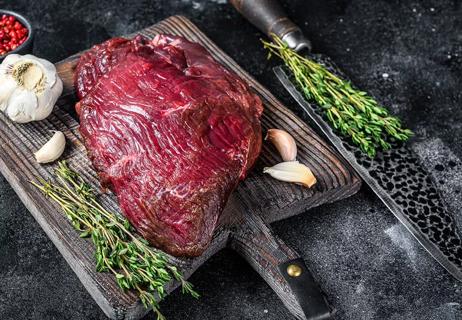Color, texture, smell and expiration date all hold important clues

It’s 6 p.m., your tummy’s growling, and you still don’t know what to make for dinner. And then, the light dawns: Somewhere in the chaos of the refrigerator, there lurks a pound of raw ground beef.
Advertisement
Cleveland Clinic is a non-profit academic medical center. Advertising on our site helps support our mission. We do not endorse non-Cleveland Clinic products or services. Policy
Sure, it’s definitely been more than a week since you bought it. And it’s starting to look a little … different. But is it still safe to eat?
And if it has gone bad and you do eat it, will it hurt you?
We talked with registered dietitian Lillian Craggs-Dino, DHA, RDN, LD, to find the answers to these meaty questions, and many more.
In the whole, wide universe of things to eat, ground beef holds a special place.
Basically, because we eat a lot of it. In fact, data from the United States Department of Agriculture (USDA) indicates that in 2020, the world ate more than 130 billion pounds of beef. In the United States, ground beef makes up more than half of the beef consumed in the country. In 2017, for instance, Americans ate, on average, a whopping 54.5 pounds of ground beef in dishes like burgers, tacos, meatballs, chili and other tasty meals.
But at the same time, its very nature creates substantial health risks. The process of grinding up beef creates more surface area, which means more places for microorganisms to hide. As a result, ground beef can go bad quickly — more so than a steak or other larger cuts of meat.
“Ground beef is a particular concern,” notes Dr. Craggs-Dino, “because its spoilage isn’t always as obvious as other products. If you’re looking at something that has fuzzy mold sprouting on it, you are probably going to think, ‘Oh, I’m not eating that.’ But ground beef can be a little trickier. It can actually be starting to spoil, and you might not notice anything.”
Advertisement
Two types of microorganisms can take up residency in ground beef. The first kind, spoilage bacteria, can cause the meat to lose quality and develop a bad odor and taste, but they generally aren’t harmful to eat. Pathogenic bacteria, on the other hand, can’t be seen or smelled, but they are dangerous and can lead to food poisoning.
To make things even more complicated, if spoilage bacteria are present, their pathogenic buddies are likely to be close behind. So, even if spoilage bacteria won’t make you sick, their presence is a sign that bad actors like E. coli, Salmonella or Campylobacter are there as well.
Luckily, there are often signs that spoilage has occurred. Keep them in mind when you examine a package of ground meat:
“Outside, ground beef should look nice and pink,” says Dr. Craggs-Dino. “Sometimes, the inside may look a little brown, and that’s OK, too. But if it’s starting to turn a funky gray — inside or out — then you know something is a little off. Your food could already be spoiled by that point.”
“If you open the package and the meat feels or looks slimy, that’s a problem,” states Dr. Craggs-Dino. “Fresh ground beef should be a little firm to the touch and crumbly. But if it’s sticky and looks wet, that’s not so good. I know it sounds kind of gross. But hopefully, a person would see that and get turned off.”
The smell of fresh ground beef is barely noticeable. But it’s a different story if the meat has gone bad, says Dr. Craggs-Dino. “You open the package and it just doesn’t smell right. If it smells rancid, or tangy, or just plain putrid, that’s a sign of spoiled meat.”
The expiration date printed on the label is another important clue to your meat’s safety. Sometimes called the “best before” date, the expiration date tells you when the food is likely to start going bad. The guidance here is simple. “Don’t eat food past the expiration date,” advises Dr. Craggs-Dino. “If you aren’t going to be able to use it by that date, freeze it. Your ground beef will keep in the freezer for about four months.”
And don’t confuse the expiration date with the sell-by date, she cautions. “The sell-by date is a guideline for the retailer, saying, ‘Look, we can keep this meat on the shelf until this day.’ Assuming you buy it, bring it home and put it right into the refrigerator, you can still eat the ground beef for two days after the sell-by date. If you go past that, though, you are putting yourself at risk.”
If you eat food that contains pathogens like E. coli or Salmonella, chances are you’ll get a foodborne illness like food poisoning.
Advertisement
And food poisoning is no joke, stresses Dr. Craggs-Dino.
“All of us have probably had a touch of food poisoning at least once in our lives,” she says. “You know, you go out, you have a lovely meal, it tastes wonderful, and then you go home and your stomach starts churning. Then, you start feeling gassy and an hour later, you’re having diarrhea. That’s a type of foodborne illness.”
Unfortunately, not all cases are that mild. “Foodborne illnesses can transition into something really dangerous,” she cautions. “If you are starting to vomit, if you are running a fever, those are symptoms of a dangerous infection. At that point, I recommend you go to the ER, since this can develop into a life-threatening illness.”
Children under the age of 5, people older than 65, people who are pregnant and people with weakened immune systems are at particular risk for serious consequences from foodborne illnesses. They should always see a healthcare provider if food poisoning is suspected.
According to the U.S. Centers for Disease Control and Prevention (CDC), serious long-term effects of foodborne illness can include:
Advertisement
For some people, these health problems can last for weeks or months after recovering from a foodborne illness. For others, they never go away.
The anonymous sage had it right: “When in doubt, throw it out.” It’s not worth the risk of illness.
You bought the ground beef. Now what do you do with it?
When it comes to safe food handling, the USDA offers these guidelines:
Advertisement
Color, texture, smell and the expiration date all offer important clues if your ground meat has gone bad or if it’s safe to eat. And if you have any doubts about the quality or freshness of your ground beef, throw it out — the alternative could be food poisoning.
But in the meantime, you can ensure your ground beef stays fresh and wholesome as long as possible with these four rules:
Now, fire up the grill, wash your hands and watch those burgers sizzle!
Learn more about our editorial process.
Advertisement

Extended outages lasting more than four hours can make food in your fridge unsafe to eat

Microwaves use non-ionizing radiation and haven’t been shown to cause cancer — follow food safety practices and use microwave-safe containers

Once perishable food hits the table, it’s typically good for about two hours

No! Be sure to put your leftovers in the fridge

Don’t let any turkey or stuffing go to waste this year!

Not all processed foods are bad, but the fewer the ingredients, the better

Check reviews, check labels and double check packaging

Keep these tips in mind during hunting season

If you’re feeling short of breath, sleep can be tough — propping yourself up or sleeping on your side may help

If you fear the unknown or find yourself needing reassurance often, you may identify with this attachment style

If you’re looking to boost your gut health, it’s better to get fiber from whole foods